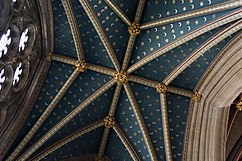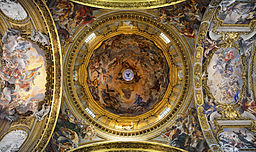
Back Teito AN سقف (بناء) Arabic ܩܪܫܬܐ ARC Techu AST سقف AZB Lobas BAT-SMG Столь BE Столь BE-X-OLD Таван Bulgarian Sel BR
A ceiling /ˈsiːlɪŋ/ is an overhead interior roof that covers the upper limits of a room. It is not generally considered a structural element, but a finished surface concealing the underside of the roof structure or the floor of a story above. Ceilings can be decorated to taste, and there are many examples of frescoes and artwork on ceilings, especially within religious buildings. A ceiling can also be the upper limit of a tunnel.
The most common type of ceiling is the dropped ceiling,[citation needed] which is suspended from structural elements above. Panels of drywall are fastened either directly to the ceiling joists or to a few layers of moisture-proof plywood which are then attached to the joists. Pipework or ducts can be run in the gap above the ceiling, and insulation and fireproofing material can be placed here. Alternatively, ceilings may be spray painted instead, leaving the pipework and ducts exposed but painted, and using spray foam.
A subset of the dropped ceiling is the suspended ceiling, wherein a network of aluminum struts, as opposed to drywall, are attached to the joists, forming a series of rectangular spaces. Individual pieces of cardboard are then placed inside the bottom of those spaces so that the outer side of the cardboard, interspersed with aluminum rails, is seen as the ceiling from below. This makes it relatively easy to repair the pipes and insulation behind the ceiling, since all that is necessary is to lift off the cardboard, rather than digging through the drywall and then replacing it.
Other types of ceiling include the cathedral ceiling, the concave or barrel-shaped ceiling, the stretched ceiling and the coffered ceiling. Coving often links the ceiling to the surrounding walls. Ceilings can play a part in reducing fire hazard, and a system is available for rating the fire resistance of dropped ceilings.





